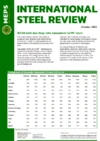Crude steel production drops 5% in April
Figures from worldsteel show that global crude steel output totalled 162.7 million tonnes in April – down 5.1% compared with the same month in 2021. This is the ninth month in a row to record a year-on-year decrease.
The decline, starting in mid-2021, was originally attributed to the rise in gas and electricity costs affecting production in this energy-intensive industry. However, more recently, the resurgence of Covid-19 in China, and the disruption to supply chains caused by the conflict between Russia and Ukraine, became the dominant factors.
China
Steel consumption in China fell, in April. The country continues to struggle with lockdowns imposed to control the latest Covid-19 outbreak. Several financial firms and ratings agencies have subsequently reduced their 2022 growth forecasts for China to an average of 4.5%, which is well below the government’s official target of 5.5%. Despite this, Chinese crude steel production reached 92.8 million tonnes, in April, accounting for 57% of the global total.
The country is working towards reducing its dependency on steel produced in blast furnaces. Projects to build approximately 14 million tonnes of new EAF-based steelmaking capacity have been announced so far, in 2022. China wants this method to account for between 15% and 20% of its total output, by 2025.
Russia
Russian crude steel production held firm, last month, despite the impact of economic sanctions and the embargo on finished steel products into Europe. Its April output was assessed at 6.4 million tonnes by worldsteel.
However, it must be noted that figures since the outbreak of the conflict are estimates due to the lack of official reporting.
European Union
Crude steel production, in the EU, was down to 12.3 million tonnes, in April. First quarter HRC, CRC and HDG imports into the region fell by 25%, 10% and 40%, respectively. The reduction in supply from Ukraine and Russia has yet to be fully replaced by other countries.
Downstream demand, such as that from the automotive industry, has shrunk. This is contributing to Europe steel price reductions. Registrations of passenger and commercial vehicles in the EU decreased by approximately 25%, in April, compared with equivalent figures in 2021.
The steel industry in Europe is focused on transferring to less carbon-intensive production methods, due to its climate commitments and the desire to reduce dependency on Russian energy sources. However, this will take time to bear fruit.
United States
Production in the United States reached 6.9 million tonnes in April 2022, taking the year-to-date total to 27.1 million tonnes. This is 1.7% lower than at the same point in 2021.
Output declined as companies focused on taking less efficient plants out of service. Approximately 2.1 million tonnes per year of capacity was lost as Cleveland-Cliffs shuttered blast furnace #4 at its Indiana Harbour facility.
Figures from the American Iron and Steel Institute showed that the capacity utilisation rate for the month rose by 2.5%, year-on-year, to 80.6%.
Iran
In April, Iranian crude steel output is estimated to have declined by more than 20%, year-on-year, to 2.2 million tonnes. This can be attributed to a downturn in the local economy.
The government increased monetary supply as sanctions tightened, leading to severe inflationary pressures. This has been exacerbated by the effect the Ukrainian conflict has had in reducing the availability of essential commodities. Energy supply constraints have also had an impact on industrial demand.
India
India has bucked the global trend. Output in the first four months of this year totalled 42.3 million tonnes. This is 2.5 million tonnes more than in the same period in 2021.
However, it has yet to be seen what the recently announced 15% export tax on HRC, CRC and HDG will have on these volumes. In total, India exported close to 9 million tonnes of this material, in 2021.

Source:
International Steel Review
The MEPS International Steel Review is an essential monthly publication, offering professional analysis and insight into carbon steel prices around the world.
Go to productRequest a free publication





